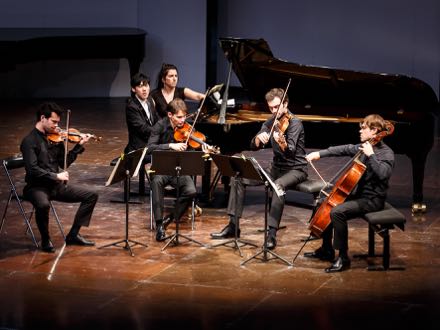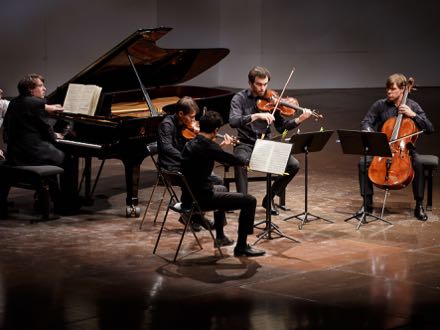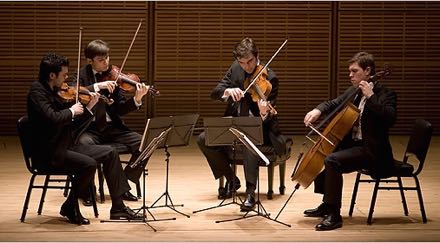Recent Reviews:
The Modigliani Quartet at the Roque d'Antheron (July 27, 2015)
The Modigliani Quartet at the Aix Festival (July 14, 2015)
The Modigliani Quartet at the Roque d'Antheron
On July 27 the prestigious Festival international de piano in La Roque d’Antheron (a village in the Luberon) entered the third day of its annual exhaustive exploration — twenty-nine straight days — of the piano repertory with an evening of piano quintets.
It was “Nuit de piano” at the festival, actually two concerts back to back with a 40 minute break for dinner, the first concert crowned by a performance of Robert Schumann’s groundbreaking 1842 piano quintet in E-flat Major. and the second concert crowned by César Franck’s explosive 1879 piano quintet in F minor.

Pianist Haochen Zhang with the Modigliani Quartet
Photos courtesy of the Festival International de Piano, La Roque d'Antheron.
The stars of the evening were not the pianists — Shanghai born, Curtis Institute (Philadelphia) trained twenty-five year-old Haochen Zhang for the Schubert and Paris born and trained, twenty-nine year-old Jean-Frédéric Newburger — but the Modigliani String Quartet founded in 2003 by four young men studying at the Paris Conservatory.
This quartet has achieved considerable fame for the ambitious attack and the absolute concentration it achieves in a single and solid voice, and in no small part made possible by its quartet of perfectly matched 17th and 18th century Italian instruments (Guadagnini, Gagliano, Mariani and Goffriller). The quartet’s tone is wooden rather than warm, the sound is big and sophisticated rather than beautiful.
Pianist Zhang chose to play a Hamburg Steinway with a clear tone, and a bell-like sound, an instrument well-matched to Schumann’s Kreistleriana (1838) which he performed before he joined the quartet for the quintet. Mr. Zhang’s musicianship is elegant and delicate, these qualities achieved by a parity of individual notes throughout the lower and upper ranges of the concert piano. This created a translucent performance of this work that sang out the freshness of spirit of the young Schumann rather than dwelling on the inherent romanticism of its emotional contrasts. Mr. Zhang often paused between the movements further distancing Schumann’s intended conflicts of personality.
The Modigliani Quartet attacked the Schumann quintet less aggressively than it might have and succeeded in a performance that was stylistically much less severe than its take on Beethoven two weeks ago at the Aix Festival. The fame of this quintet is that it was the first time the piano rather than the double bass made the string quartet a quintet. In this performance the forces were unmatched, the piano never fully fitting into the musical texture. The quartet did accomplish the expected emotional contrasts with an unexpected, indeed welcomed naturalness.

Pianist Jean-Frédéric Neuburger with the Modigliani Quartet
Pianist Jean-Frédéric Neuburger chose a Hamburg Steinway with a darker tone and smoother sound to build the massive tonal agglomerations of Franck’s stylistically mature quintet. The work's forty minute length weighs heavily on the listener, and again here I wished for a heavier intrusion of the piano than the sometimes bombastic Mr. Neuburger chose to provide, though as it was the emotional and musical pretension of the work was well expressed by the pianist. It is not a work that offers a string quartet much possibility of expression, their place rather to provide a constant musical continuum as if they were the hardworking string sections of a symphony orchestra.
The musical jewels of the evening were a performance of Janáček’s Piano Sonata 1.X.1905 (1906) and Dvořák’s twelth quartet, the “American.” The Janáček was an inspired choice of repertoire to open this evening as its minimal means (few notes and open textures) focused our ears into the intimacy of chamber music, the piano alone on the huge stage. The extreme elegance of Mr. Zhang’s playing was enchanting, and he revealed an unexpected virtuosity for the piece in spectacular left hand bursts in the Presentment. However Mr. Zhang’s performance had nothing at all to do with the occasion and nervousness of this early twentieth century expressionism.
The Dvořák “American” quartet (1893) proved a perfect piece to show the animus of the Modigliani Quartet, singing out the pseudo folk songs of the great prairies of the American midwest (he wrote the work while in Iowa). It was attacked with fiddler’s fury, the quartet’s first violinist Philippe Bernhard in his element, and the concentration was passed between the players, violist Laurent Marfaing and cellist François Kieffer engaging in charming duets in the extended lento. In fact the lento took us to a level rarefied lyricism and held us there for what seemed forever. The parody quality of this splendid Dvořák quartet serves these players’ hyper-sophisticated take on the string quartet literature.
The Modigliani Quartet at the Aix Festivaln
Our evening continued (this review is extracted from my opera review of the opera Svadba) across town at the recital hall of Aix’s Darius Milhaud Conservatory of Music, part of Aix’s magnificent performing arts campus. Unlike the ill conceived auditorium of the next door Grand Théâtre de Provence (it is round), this recital hall is appropriately shaped (oblong) and has a very fine, live acoustic.

The Modigliani Quartet
The Modigliani Quartet performed Beethoven’s 4th string quartet (Op. 18), Ravel’s famed Quartet in F Major, and relevant to the evening’s slavic focus, the Hungarian Ernö Dohnányi’s 1926 third quartet (Op. 33). What this fine quartet has to do with Modigliani, if anything, is an open question. There is no question however that it is a quartet with attitude. Each of the three works were ambitiously attacked to the degree that you feared it was not humanly possible to keep up such volume, speed and intensity for the extended duration of four movements. It was.
Like the six women of Svadba the four men of the quartet moved in soundscapes, achieving a sweeping lyricism that ignored the musical structures of the printed page, frustrating however some listeners with this lack of apparent structure. The unique sound of this quartet is symphonic, the four instruments precisely matched in a very wooden tonal color (the instruments are not credited in the program). The unison breathing of the four men was made very apparent either through the transparent acoustic of the room or the aural concentration the quartet motivated in the listener. It was big playing by four young virtuosos.
The Dohnányi is an edgy and anxious piece, the second movement alternating huge, nervous variations on a chorale theme with quiet (here played pianissimo) moments. The final moments of the last movement well echoed the extreme excitement of the intense Svadba scenes before it roared in tonal edginess to a horserace finish. It is big music, good music.